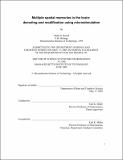Multiple spatial memories in the brain : decoding and modification using microstimulation
Author(s)
Histed, Mark H
DownloadFull printable version (1.438Mb)
Other Contributors
Massachusetts Institute of Technology. Dept. of Brain and Cognitive Sciences.
Advisor
Earl K. Miller.
Terms of use
Metadata
Show full item recordAbstract
Sequential processing --- using multiple sensory stimuli to plan and control a set of ordered movements --- is a central aspect of human behavior. Because previous and future movements must be stored during the execution of any movement in a sequence, memory is an indispensable aspect of sequential behavior. To study how memory is used to link sensory inputs to sequential motor outputs, we have used the oculomotor system as a model. We trained monkeys to remember the location of two spatial cues over a brief delay, and then make two eye movements to the remembered locations in the order that they appeared. We explored the role of two different frontal eye movement areas, the frontal and supplementary eye fields (FEF and SEF) during this memory delay. While both the FEF and SEF have shown to be important for sequential behavior, their individual roles are unknown. Here, using physiology, we show that the FEF is important for storing the location of multiple cues and their order in memory. In the SEF, we show that memory period stimulation can affect the order of a sequence, changing the goal of the entire sequence but not the individual movement components. (cont.) Thus, both areas appear to play complementary roles in sequential planning: the FEF stores target locations, while the SEF appears to control the order of a response sequence, coding entire sequences without affecting the locations of the intermediate targets. This work bears on several outstanding questions in the field. It clarifies the individual roles of the FEF and SEF during sequencing: the FEF may serve as a buffer for multiple memories while the SEF plays a role in organizing movement sequences. It relates several prior SEF results, suggesting that a primary role of SEF may be to specify movements by their goal. Finally, we suggest that this goal-centered scheme may be a fundamental way that many different types of movements are encoded.
Description
Thesis (Sc. D.)--Massachusetts Institute of Technology, Dept. of Brain and Cognitive Sciences, 2005. This electronic version was submitted by the student author. The certified thesis is available in the Institute Archives and Special Collections. Includes bibliographical references (leaves 87-97).
Date issued
2005Department
Massachusetts Institute of Technology. Department of Brain and Cognitive SciencesPublisher
Massachusetts Institute of Technology
Keywords
Brain and Cognitive Sciences.